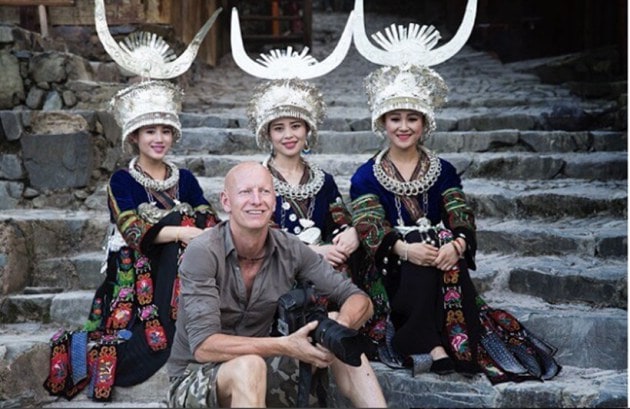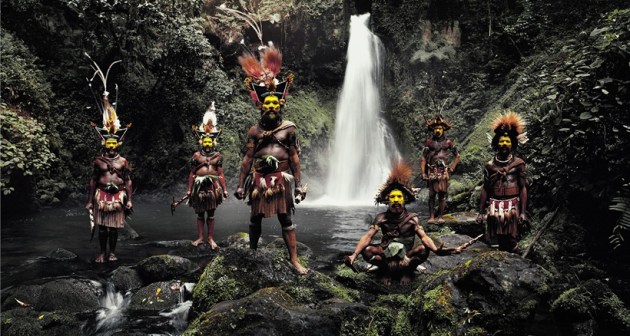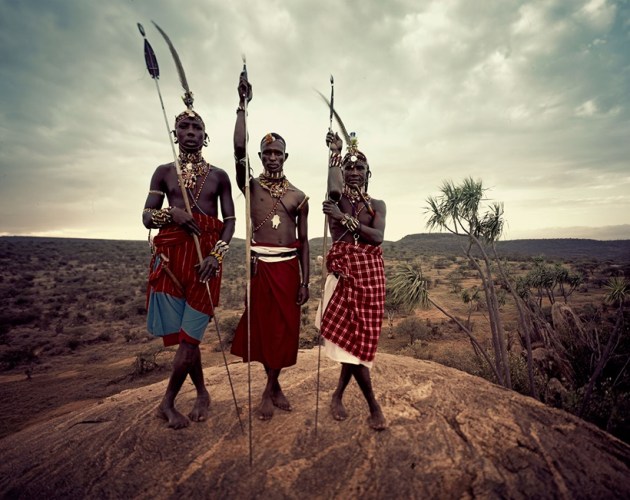This photographer beautifully captures the world’s vanishing tribes
Jimmy Nelson, a popular British photojournalist beautifully captures the indigenous tribes across the world by travelling and spending time with them to carefully document their interesting lives.
August 10, 2016 18:41 IST
 1 / 16
1 / 16Jimmy Nelson is a British photographer and photojournalist known best for his stunning photographs of tribal and indigenous people. Nelson has travelled across the world and documented the ways of life of communities rarely seen or heard about. Chukchi of Chukotka peninsula in Siberia, Kalam in Papua New Guinea, the Rabari in Gujarat and Rajasthan in Western India — to name a few are some of the many pristine communities that Nelson has beautifully documented. The photographer has travelled the length and breadth of countries like Ethiopia, Namibia, Nepal, China, New Zealand, India, etc. photographing various tribes. He has also founded the Jimmy Nelson Foundation, which claims to celebrate the polychromatic culture of the world. Here are 15 photographs of his that showcase the lives of lesser-known communities and the intriguing lives they live, explained by Nelson in his own words. (Source: Jimmy Nelson/Instagram)
 2 / 16
2 / 16It is believed that the first Papua New Guineans migrated to the island over 45000 years ago. Today, over 3 million people, half of the heterogeneous population, live in the highlands. Some of these communities have engaged in low-scale indigenous conflict with their neighbours for millennia. (source: jimmynelson.com)
 3 / 16
3 / 16Settlement in the 85 Vanuatu islands dates back to around 500 BC. There is evidence that Melanesian navigators from Papua New Guinea were the first to colonise Vanuatu. Over centuries, other migrations followed. Nowadays, all the inhabited islands have their own languages, customs and traditions. (Source: jimmynelson.com)
 4 / 16
4 / 16The Samburu people live in northern Kenya, where the foothills of Mount Kenya merge into the northern desert. As cattle-herding Nilotes, they reached Kenya some five hundred years ago, moving southwards along the plains of the Rift Valley in a rapid, all-conquering advance. (Source: jimmynelson.com)
 5 / 16
5 / 16Ladakh (meaning ‘land of the passes’) is a cold desert in the Northern Indian state of Jammu and Kashmir. It is divided into the mainly Muslim Kargil district and the primarily Buddhist Leh district. The people of Ladakh have a rich folklore, some of which date back to the pre- Buddhist era. (Source: jimmynelson.com)
 6 / 16
6 / 16One of the indigenous groups inhabiting the Baliem Valley region, in the midst of the Jayawijaya mountain range of Papua Indonesia, is the Yali ‘Lords of the Earth’. They live in the virgin forests of the highlands. The Yali are officially recognised as pygmies, with men standing at just 150 cm tall.(Source: jimmynelson.com)
 7 / 16
7 / 16Yangshuo County is a county under the jurisdiction of Guilin City, in the northeast of Guangxi, China. Its seat is located in Yangshuo Town. Surrounded by karst peaks and bordered on one side by the Li River it is easily accessible by bus or by boat from nearby Guilin. Cormorant fishing is a traditional fishing method in which fishermen use trained cormorants to fish in the Li river. Historically, cormorant fishing has taken place in Japan and China since about 960 AD. (Source: jimmynelson.com)
 8 / 16
8 / 16 9 / 16
9 / 16The former kingdom of Lo is linked by religion, culture and history to Tibet, but is politically part of Nepal. Now Tibetan culture is in danger of disappearing, it stands alone as one of the last truly Tibetan cultures existing today. Until 1991 no outsiders were allowed to enter Mustang. (Source: jimmynelson.com)
 10 / 16
10 / 16For almost 1,000 years, the Rabari have roamed the deserts and plains of what is today western India. It is believed that this indigenous group, with a peculiar Persian physiognomy, migrated from the Iranian plateau more than a millennium ago. The Rabari are now found largely in Gujarat and Rajasthan. (Source: jimmynelson.com)
 11 / 16
11 / 16The Kazakhs are the descendants of Turkic, Mongolic and Indo-Iranian indigenous groups and Huns that populated the territory between Siberia and the Black Sea. They are a semi-nomadic people and have roamed the mountains and valleys of western Mongolia with their herds since the 19th century. (Source: jimmynelson.com)
 12 / 16
12 / 16The Islands are shrouded in mystery, history and legend. They are geographically so isolated that they are the most remote island archipelagos from any continent on the planet. Located 1500km north of Tahiti and spread over 12 islands of which only a few are permanently inhabited. (Source: jimmynelson.com)
 13 / 16
13 / 16Hiva Oa is also called the garden of the Marquesas. It’s an island so fertile that it leads to a celebration of natural color and creativity being displayed in flowers that adorn all the Marquesian women. It felt as if the whole island turned up over the next few days to show how proud they are of their cultural traditions. Children especially made an effort to use all forms of plant and flowers to ornate their body. Mother nature provided inspiration for all. (jimmynelson.com)
 14 / 16
14 / 16Nomadic and colourful horsemen and cowboys have wandered the prairies as early as the 1700s, when wild Cimarron cattle overpopulated the flatlands. In the 18th century, when leather was in high demand, Gauchos arose to clandestinely hunt the huge herds of horses and cattle. (Source: jimmynelson.com)
 15 / 16
15 / 16A number of different indigenous groups have lived scattered across the highland plateau for 1000 years, in small agrarian clans, isolated by the harsh terrain and divided by language, custom and tradition. The legendary Asaro Mudmen first met with the Western world in the middle of the 20th century. (Source: jimmynelson.com)
 16 / 16
16 / 16The Himba are an ancient indigenous group of tall, slender and statuesque herders. Since the 16th century they have lived in scattered settlements, leading a life that has remained unchanged, surviving war and droughts. The tribal structure helps them live in one of the most extreme environments on earth. (Source: jimmynelson.com)











